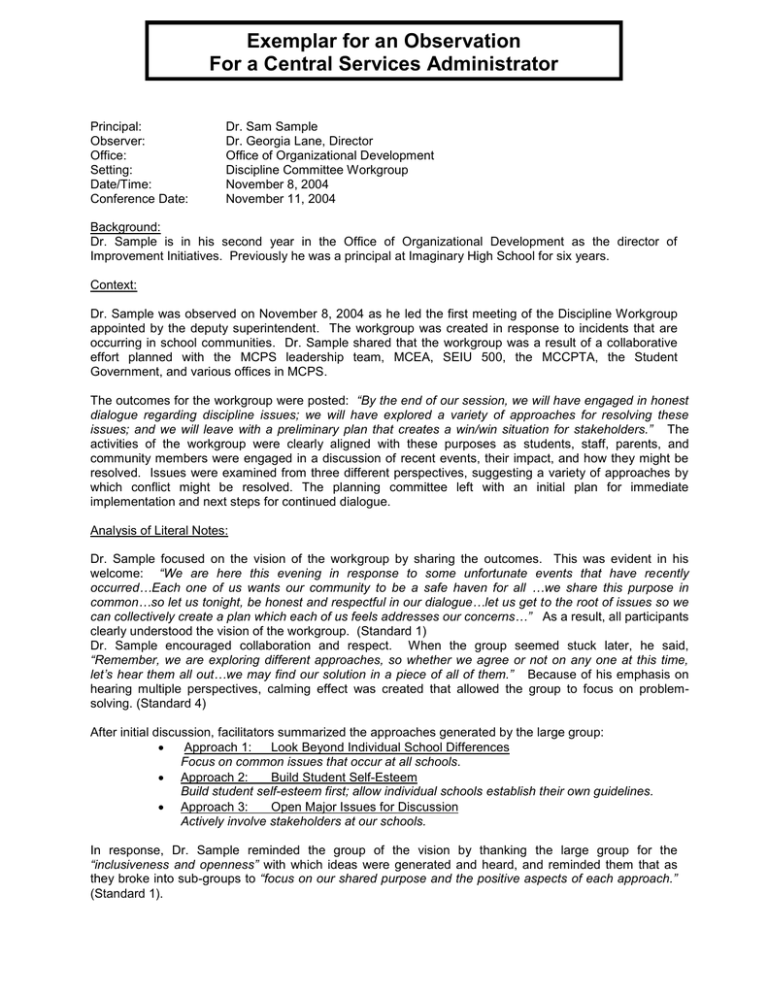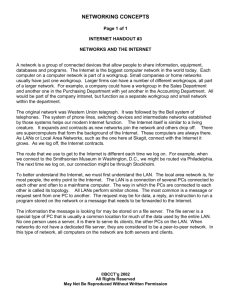Exemplar for an Observation for a Central Services Administrator
advertisement

Exemplar for an Observation For a Central Services Administrator Principal: Observer: Office: Setting: Date/Time: Conference Date: Dr. Sam Sample Dr. Georgia Lane, Director Office of Organizational Development Discipline Committee Workgroup November 8, 2004 November 11, 2004 Background: Dr. Sample is in his second year in the Office of Organizational Development as the director of Improvement Initiatives. Previously he was a principal at Imaginary High School for six years. Context: Dr. Sample was observed on November 8, 2004 as he led the first meeting of the Discipline Workgroup appointed by the deputy superintendent. The workgroup was created in response to incidents that are occurring in school communities. Dr. Sample shared that the workgroup was a result of a collaborative effort planned with the MCPS leadership team, MCEA, SEIU 500, the MCCPTA, the Student Government, and various offices in MCPS. The outcomes for the workgroup were posted: “By the end of our session, we will have engaged in honest dialogue regarding discipline issues; we will have explored a variety of approaches for resolving these issues; and we will leave with a preliminary plan that creates a win/win situation for stakeholders.” The activities of the workgroup were clearly aligned with these purposes as students, staff, parents, and community members were engaged in a discussion of recent events, their impact, and how they might be resolved. Issues were examined from three different perspectives, suggesting a variety of approaches by which conflict might be resolved. The planning committee left with an initial plan for immediate implementation and next steps for continued dialogue. Analysis of Literal Notes: Dr. Sample focused on the vision of the workgroup by sharing the outcomes. This was evident in his welcome: “We are here this evening in response to some unfortunate events that have recently occurred…Each one of us wants our community to be a safe haven for all …we share this purpose in common…so let us tonight, be honest and respectful in our dialogue…let us get to the root of issues so we can collectively create a plan which each of us feels addresses our concerns…” As a result, all participants clearly understood the vision of the workgroup. (Standard 1) Dr. Sample encouraged collaboration and respect. When the group seemed stuck later, he said, “Remember, we are exploring different approaches, so whether we agree or not on any one at this time, let’s hear them all out…we may find our solution in a piece of all of them.” Because of his emphasis on hearing multiple perspectives, calming effect was created that allowed the group to focus on problemsolving. (Standard 4) After initial discussion, facilitators summarized the approaches generated by the large group: Approach 1: Look Beyond Individual School Differences Focus on common issues that occur at all schools. Approach 2: Build Student Self-Esteem Build student self-esteem first; allow individual schools establish their own guidelines. Approach 3: Open Major Issues for Discussion Actively involve stakeholders at our schools. In response, Dr. Sample reminded the group of the vision by thanking the large group for the “inclusiveness and openness” with which ideas were generated and heard, and reminded them that as they broke into sub-groups to “focus on our shared purpose and the positive aspects of each approach.” (Standard 1). Dr. Sample demonstrated his professionalism by showing respect and openness with the group. When facilitators divided the large group into three discussion groups to deliberate and reflect on the three choices, Dr. Sample joined a sub-group as an active participant. He was careful, however, to let the direction and decisions come from the group. “No, no…go ahead, Jim (student) –You have an important perspective.” In response, Jim shared that “we (students) want to talk about these issues too…if we could do this at school, we could create a positive effect among the student body…” As a result of Dr. Sample’s approach, students and other participants felt free to share their own opinions. (Standard 5) Dr. Sample allowed group processes to operate that allowed the workgroup to come to consensus. Later, when the whole group reconvened to report out at the end of the evening, the group consensus was to create an initial plan drawing from all three approaches. Two steps for immediate implementation resulted: (1) Create forums at each school made up of student leaders from diverse backgrounds to discuss discipline issues. These forums will be supported by school staff, S.G.A. members, and trained facilitators. (2) Create a system-wide forum with representation from each school to discuss school system discipline issues that might require a system-wide approach. The planning committee agreed to meet in a month to review progress. As a result of Dr. Sample’s enthusiastic approach and implicit use of group processes, the group reached consensus on a two-step action plan. (Standard 3) Post-Observation Conference: In the post-observation conference, I shared my notes, summary, and observations with Dr. Sample. We discussed particularly how the students in his group “held their own” in response to comments and questions posed by the adults, and generated key ideas that contributed to the action plan. Dr. Sample shared that this level of student participation is the norm and was an explicitly communicated expectation by the planning committee. “We want to know…need to know what students think; they are experiencing these issues first hand, and many times they bring us insights we as adults would never have known.” This statement indicated his strong belief system that students are stakeholders and should be involved in decision-making. (Standard 4.) I commended him for taking the initiative to chair this committee, for initiating the community partnership, for creating a forum for discussion and resolution, and for ensuring equal participation on the part of all stakeholders. I highlighted with Dr. Sample how this observation was strong evidence of his capacity to “manage human and material resources to cultivate and support a safe and healthy environment” (Standard 3) Summary: Dr. Sample has demonstrated skills in four of the leadership standards. This is clear evidence that he is effectively fulfilling the requirements of his position. __________________________________________ Dr. Sam Sample __________ Date __________________________________________ Dr. Georgia Lane ___________ Date
